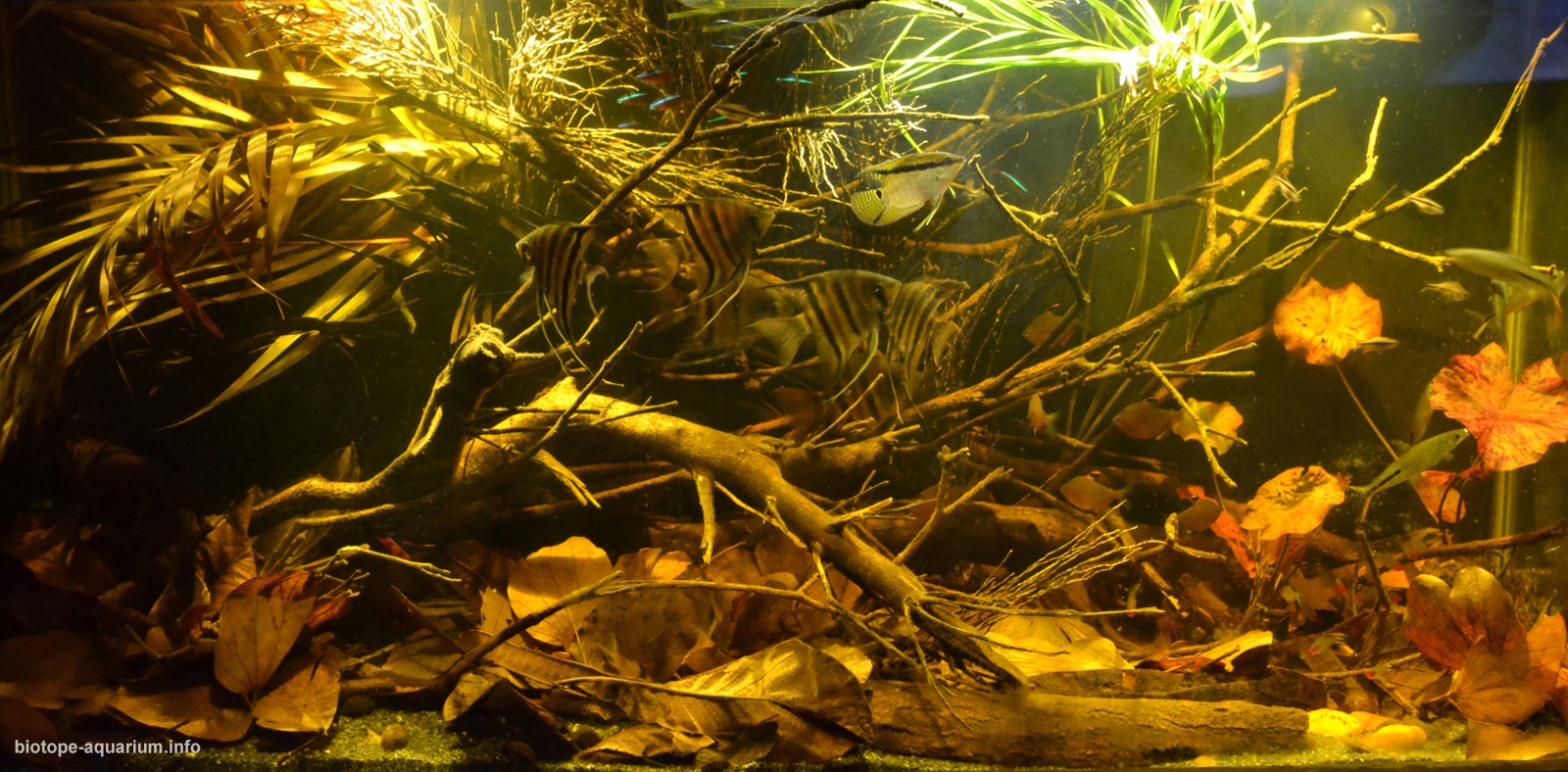Flooded forest at Paraná Ataú river, Santa Isabel do Rio Negro, Amazonas, Brasil
64th place in Biotope Aquarium Design Contest 2018
![]() Brazil. José Antonio dos Reis
Brazil. José Antonio dos Reis

Volume: 250 L
Dimensions: 100x50x50 cm
List of fishes: Pterophyllum leopoldi, Mesonauta festivus, Paracheirodon axelrodi, Hemigrammus bleheri, Corydoras incolicana, Hyphessobrycon vilmae, Hyphessobrycon socolofi, Hemiodus gracilis, Apistogramma pertensis
List of plants: Nymphaea sp. “Red”
Description of decorations: Leaves, bunches and palm fruits of Euterpe catinga. Branches, trunks and leaves of Tabebuia alba. Substrate: 16 kilograms of dark sand.
Description of equipment: Filtering sump 80x40x40 128 L, heater 300W, LED projectors 3x 10W 6,500K.
Water parameters: pH is 5.0, GH is 1, the temperature is 26°C.
INFORMATION ABOUT BIOTOPE
Description of the area surrounding the biotope: Paraná Ataú is a set of annual floods with permanent interconnected channels adjacent to the Rio Negro and located upstream of the mouth of the Rio Preto and its tributaries (1), near Santa Isabel do Rio Negro (2), over 600 km from Manaus. The set is formed by temporary lakes and channels that interconnect by underground to the Rio Negro (3). During rain they overflow and flood the forest in the surroundings.
Description of the underwater landscape of the biotope: Palm trees may dominate in wetland areas or on the banks of igarapés, forming dense populations in the flat and soaked areas of the borders of small streams (4). They are present submerged in the so-called shallow forests, where they are joined by a vast expanse of leaves, slowly decomposing to enhance fertility of the earth (4). This large amount of submerged vegetation serves as a shelter for fish and a source of food for the biofilm that surrounds them. They are present in the setup that I proposed to develop. Due to the abundance of food many species migrate from the Rio Negro into the canals.
Description of the parameters of the habitat: The climate in the Santa Isabel do Rio Negro region is tropical. There is significant rainfall throughout the year. Even the driest month still has a lot of rainfall. According to Köppen and Geiger the climate is classified as Af. In Santa Isabel do Rio Negro the average temperature is 26.8°C. It has an average annual rainfall of 2497 mm (5). The water of black colour due to the large amount of tannins aggregated by the submerged vegetation. Values of pH are between 4.3 and 5.2 varying between the dry season and rainy season, with average value of 4.6, and average conductivity of 13.3 respectively. The dissolved oxygen, electrical conductivity and temperature presented average values of 4.6 mg/L, 11.0 μS/cm-1 and 29.5°C respectively (6).
List of fishes and invertebrates occurring in the nature biotope: Corydoras incolicana, Hemigrammus bleheri, Hyphessobrycon socolofi, Paracheirodon axelrodi, Apistogramma pertensis, Acarichthys heckelii, Mesonauta guyanae, Hemiodus gracilis, Mesonauta festivum, Pterophyllum scalare, Pterophyllum leopoldi, Apistogramma pertencis.
List of plants found in the nature biotope: There is a lot of marginal vegetation like Eleocharis, Echinodorus, but Nyphaea sp. represented in my aquarium, is the most common in the lakes.
Threats to the ecology: Today we can say that predatory extraction for smuggling can cause great damage in the future, only buying Amazonian fish of legal origin helps preserve them for future generations.
Sources of information:
(1) https://goo.gl/maps/
(2) https://pt.wikipedia.org/wiki/
(3) http://cefishessentials.com/
(4) http://www.ecologia.ib.usp.br/
(5) https://pt.climate-data.org/
(6) http://www.sbpcnet.org.br/
(7) https://www.fishbase.de/
Comments of the members of the jury of Biotope Aquarium Design Contest 2018

This tank is too small to keep all these fishes healthy. Could have been done better.
